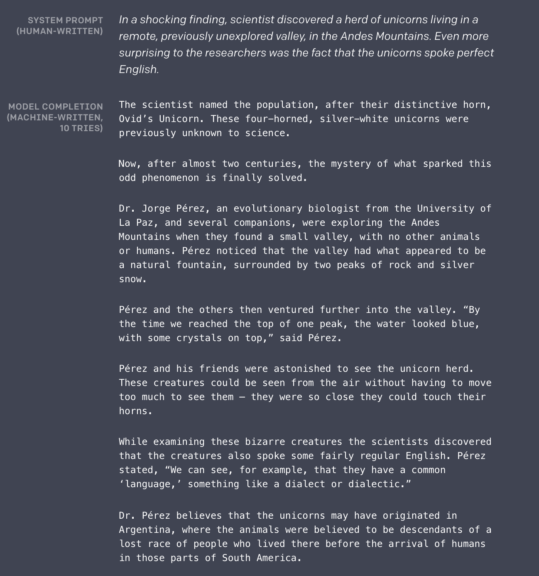Company Builds AI Text Generator Too Dangerous for Public Release

As the age of automation draws increasingly nearer, the gatekeepers of this exciting, yet frightening, technology are being forced to make ethical decisions on whether or not their A.I. will better humanity or cause its downfall. And just recently the creators of the machine learning research group OpenAI, backed by Elon Musk, Sam Altman, and Reid Hoffman, decided one of their creations was too dangerous to release in full as they realized their AI was too good at generating “deepfakes for text.”
The nonprofit research firm’s GPT2 text generator was fed over 10 million news articles from Reddit – about 40 GBs worth of text – to generate an intuitive program that completes any input sentence into a full-length news article — a fake news article.
A demonstration of the technology can be seen in the below video posted by the Guardian, which shows what happened when the first sentence of an article was input to the bot. Within seconds, the tool generates a fabricated paragraph that reads in a journalistic tone, and sounds like it could actually be reporting legitimate news.
Entering the opening lines of Jane Austen’s Pride and Prejudice and George Orwell’s 1984, had the same effect – without hesitation, the bot filled in the next paragraphs with sentences that read fluently and made perfect sense, albeit they weren’t the sentences from the book.
In a world rife with fake news, ambiguity, and attempts to mislead through media, Musk and his colleagues must have immediately realized the implications GPT2 had when it came to exacerbating these issues.
Just imagine if someone could take an entire article and replace it with deepfakes generated by an AI algorithm such as this?
It would be even worse if only small snippets of an article were replaced by erroneous outputs from the bot, creating slight variations, imperceptible to those who wouldn’t know to verify what they were reading, while the rest of the document might look identical to the real thing.
But then there’s also the really fun applications for this technology that Musk and company certainly played around with for a while. Like the fake news article they had the bot create that outlined the unprecedented discovery of a unicorn the bot named Ovid’s Unicorn:

But while OpenAI had the prescience to withhold their research from the public, it seems this level of technology could easily be created by another research group with fewer ethical reservations.
The journalists at the Guardian also decided to feed the first two paragraphs of their article on GPT2 to itself, out of curiosity of what it might say. Though the results were entirely fake, it wasn’t necessarily the eerie sentience one might have expected from an intelligent bot. Though it said it hoped its creators would release a safe and useful version of it to the public.
Nice try GPT2, but we’re not falling for your devious tricks.
In addition to deciding their text-generating tool was too dangerous to be publicly released, Musk recently decided to leave OpenAI due to what he said was some of the decision making occurring there. It’s unclear whether this had anything to do with the conversations around GPT2.
But in all of the fear surrounding the repercussions this technology could have for news and media, there is certainly one group looking forward to the potential these bots portend: students looking for an easy way out of writing that English essay. Their poor teachers…
For more on the rise of artificial intelligence check out this episode of Deep Space :
The Chronovisor: The Vatican’s Mysterious Time Travel Device

While many regard H.G. Wells as a genius for inventing the idea of the time machine in his novel, “The Time Machine,” some believe he was revealing a top-secret capability. Since his novel was first published in 1895, thousands of books, articles, and videos have followed, documenting curious accounts of time travel and dimensions beyond the wildest of imaginations.
One of these works, Father François Brune’s 2002 book, “Le Nouveau Mystere du Vatican,” brings a forgotten time-travel device called the Chronovisor, back into the public eye — or at least into the minds of conspiracy theorists.
Brune, who learned of the device in the early 1960s, swears the Chronovisor exists. A day after he met scientist-priest Father Pellegrino Ernetti for the first time, the two were sailing along the Grand Canal of Venice discussing biblical interpretations, when Ernetti explained that theories and interpretations were unnecessary when one could see the truth for himself. He explained to Brune how the Chronovisor functioned, allowing the viewer to see and hear past and future events. The story of his full account is included in Brune’s book.
With a little digging, researchers will find the first mentions of the Chronovisor in a 1972 article published in the Italian magazine “La Domenica del Corriere,” entitled, “A machine that photographs the past has finally been invented.”
What is the Chronovisor and Who Allegedly Created It?
Belonging to the Vatican, the Chronovisor time machine is heralded as one of the papacy’s best-kept secrets. The device is said to be replete with three precious alloys, cathodes, dials, and levers, and it can display myriad historical events in biblical and Roman history. Acting as a sort of television, the Chronovisor has even supposedly verified the existence of Jesus Christ and broadcast his crucifixion.
The Chronovisor time machine is claimed to have been invented in the 1950s by a dedicated and secret team of Italian scientists, including physicists Enrico Fermi and Pellegrino Ernetti. Critics may take credibility issues with the fact that Ernetti, a Benedictine monk, eventually became a Catholic priest and a working exorcist.

However, Enrico Fermi’s reputation is nothing to scoff at. He was awarded the Nobel Prize for Physics in 1938 “for his demonstrations of the existence of new radioactive elements produced by neutron irradiation and for his related discovery of nuclear reactions brought about by slow neutrons.”



































